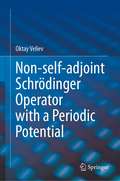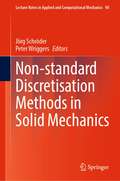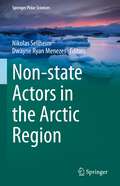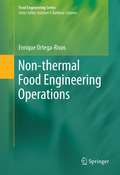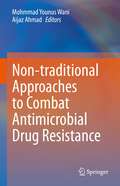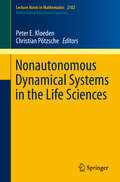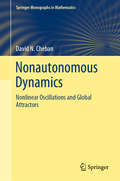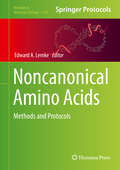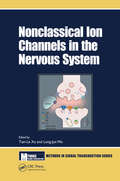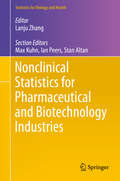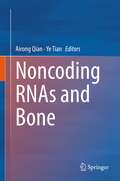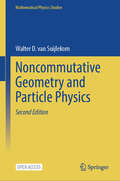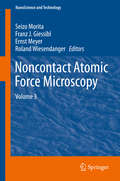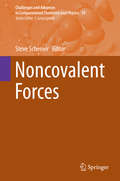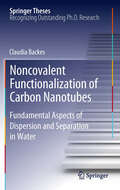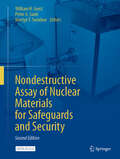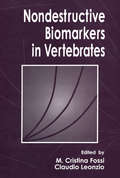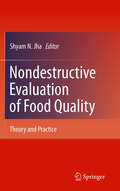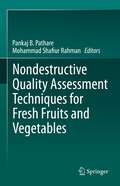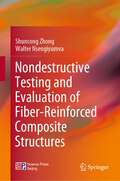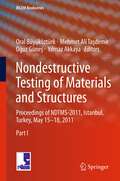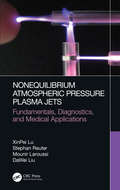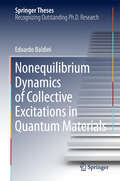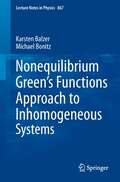- Table View
- List View
Non-self-adjoint Schrödinger Operator with a Periodic Potential
by Oktay VelievThis book gives a complete spectral analysis of the non-self-adjoint Schrödinger operator with a periodic complex-valued potential. Building from the investigation of the spectrum and spectral singularities and construction of the spectral expansion for the non-self-adjoint Schrödinger operator, the book features a complete spectral analysis of the Mathieu-Schrödinger operator and the Schrödinger operator with a parity-time (PT)-symmetric periodic optical potential. There currently exists no general spectral theorem for non-self-adjoint operators; the approaches in this book thus open up new possibilities for spectral analysis of some of the most important operators used in non-Hermitian quantum mechanics and optics. Featuring detailed proofs and a comprehensive treatment of the subject matter, the book is ideally suited for graduate students at the intersection of physics and mathematics.
Non-standard Discretisation Methods in Solid Mechanics (Lecture Notes in Applied and Computational Mechanics #98)
by Peter Wriggers Jörg SchröderThis edited volume summarizes research being pursued within the DFG Priority Programme 1748: "Reliable Simulation Methods in Solid Mechanics. Development of non-standard discretisation methods, mechanical and mathematical analysis", the aim of which was to develop novel discretisation methods based e.g. on mixed finite element methods, isogeometric approaches as well as discontinuous Galerkin formulations, including a sound mathematical analysis for geometrically as well as physically nonlinear problems. The Priority Programme has established an international framework for mechanical and applied mathematical research to pursue open challenges on an inter-disciplinary level. The compiled results can be understood as state of the art in the research field and show promising ways of further research in the respective areas. The book is intended for doctoral and post-doctoral students in civil engineering, mechanical engineering, applied mathematics and physics, as well as industrial researchers interested in the field.
Non-state Actors in the Arctic Region (Springer Polar Sciences)
by Nikolas Sellheim Dwayne Ryan MenezesThis book comprehensively discusses the role that non-state actors play in the Arctic and assesses the normative role of these actors. Beyond any organised forum, there are actors that have a significant impact on the way the Arctic is developed, adjudicated, managed, perceived, presented and represented. This book complements the literature on non-state actors in international law and international security, world politics and international relations and provides a geographical account of their role for the Arctic. The book content is not limited to a specific discipline, but takes into account different approaches to the topic. This means that it contains three types of contributions: research articles, shorter research notes and commentaries. While the research articles constitute the main body of the work, it is also the research notes which provide an insight into issues related to the topic of the book.
Non-thermal Food Engineering Operations
by Enrique Ortega-RivasA number of food engineering operations, in which heat is not used as a preserving factor, have been employed and are applied for preparation (cleaning, sorting, etc.), conversion (milling, agglomeration, etc.) or preservation (irradiation, high pressure processing, pulsed electric fields, etc.) purposes in the food industry. This book presents a comprehensive treatise of all normally used food engineering operations that are carried out at room (or ambient) conditions, whether they are aimed at producing microbiologically safe foods with minimum alteration to sensory and nutritive properties, or they constitute routine preparative or transformation operations. The book is written for both undergraduate and graduate students, as well as for educators and practicing food process engineers. It reviews theoretical concepts, analyzes their use in operating variables of equipment, and discusses in detail different applications in diverse food processes.
Non-traditional Approaches to Combat Antimicrobial Drug Resistance
by Mohmmad Younus Wani Aijaz AhmadThis book provides a detailed overview of the progress and challenges of non-traditional approaches for tackling antimicrobial resistance. The first chapter covers the factors that make microbes more likely to develop multidrug resistance. The book goes on to discuss the antimicrobial properties of propolis, essential oils and other microbial constituents that are used or under investigation to treat multidrug-resistant infections. Additionally, it covers alternative compounds that work as antimicrobial agents, their mechanisms of action, and how they might be utilized in conjunction with conventional drugs to circumvent drug resistance. The book explores the application of phage therapy and recent advancements in phage-based infection control with an emphasis on multidrug-resistant infections and discusses drug repurposing as a strategy to develop new antimicrobial agents efficiently and expeditiously. Additionally, it discusses the uses of nanoparticles in the treatment of infections brought on by multidrug-resistant pathogens and examines the use of different nanotechnology-based approaches to fudge microbial resistance mechanisms. It concludes by reviewing recent studies on microbial quorum-sensing systems and focuses on the significance of quorum-sensing systems in controlling microbial resistance mechanisms and at the same time highlights the importance and role of antimicrobial stewardship program to fight microbial infections. The book is an invaluable source of knowledge and information for academics, basic and clinical researchers, clinicians, and paramedic staff involved in one way or the other in the development and use of antimicrobial agents and strategies to combat multidrug resistance.
Nonautonomous Dynamical Systems in the Life Sciences
by Peter E. Kloeden Christian PötzscheNonautonomous dynamics describes the qualitative behavior of evolutionary differential and difference equations, whose right-hand side is explicitly time dependent. Over recent years, the theory of such systems has developed into a highly active field related to, yet recognizably distinct from that of classical autonomous dynamical systems. This development was motivated by problems of applied mathematics, in particular in the life sciences where genuinely nonautonomous systems abound. The purpose of this monograph is to indicate through selected, representative examples how often nonautonomous systems occur in the life sciences and to outline the new concepts and tools from the theory of nonautonomous dynamical systems that are now available for their investigation.
Nonautonomous Dynamics: Nonlinear Oscillations and Global Attractors (Springer Monographs in Mathematics)
by David N. ChebanThis book emphasizes those topological methods (of dynamical systems) and theories that are useful in the study of different classes of nonautonomous evolutionary equations. The content is developed over six chapters, providing a thorough introduction to the techniques used in the Chapters III-VI described by Chapter I-II. The author gives a systematic treatment of the basic mathematical theory and constructive methods for Nonautonomous Dynamics. They show how these diverse topics are connected to other important parts of mathematics, including Topology, Functional Analysis and Qualitative Theory of Differential/Difference Equations. Throughout the book a nice balance is maintained between rigorous mathematics and applications (ordinary differential/difference equations, functional differential equations and partial difference equations). The primary readership includes graduate and PhD students and researchers in in the field of dynamical systems and their applications (control theory, economic dynamics, mathematical theory of climate, population dynamics, oscillation theory etc).
Noncanonical Amino Acids: Methods and Protocols (Methods in Molecular Biology #1728)
by Edward A. LemkeThis volume covers some of the most widely used protocols on nanocanonical amino acids, providing details and advice for users to get each method up and running for their chosen application. Chapters have been divided into three parts describing methods for protein production in the test tube, in prokaryotes, and in eukaryotes. Written in the highly successful Methods in Molecular Biology series format, chapters include introductions to their respective topics, lists of the necessary materials and reagents, step-by-step, readily reproducible laboratory protocols, and tips on troubleshooting and avoiding known pitfalls. Authoritative and practical, Noncanonical Amino Acids: Methods and Protocols aims to provide readers with techniques that enable them to design new experiments and create new areas of research.
Nonclassical Ion Channels in the Nervous System (Methods in Signal Transduction Series)
by Tian-Le XuIon channels generate bioelectricity. Recent findings have documented the biophysical properties, the structure, assembly and regulation, and function and dysfunction of nonclassical nervous system ion channels. This book reviews nonclassical ion channel research, ranging from the basic biology, structure, regulations to their functions not only in normal physiology but also neurological disorders, using a variety of cutting-edge techniques and novel animal models.
Nonclinical Statistics for Pharmaceutical and Biotechnology Industries
by Lanju ZhangThis book serves as a reference text for regulatory, industry and academic statisticians and also a handy manual for entry level Statisticians. Additionally it aims to stimulate academic interest in the field of Nonclinical Statistics and promote this as an important discipline in its own right. This text brings together for the first time in a single volume a comprehensive survey of methods important to the nonclinical science areas within the pharmaceutical and biotechnology industries. Specifically the Discovery and Translational sciences, the Safety/Toxiology sciences, and the Chemistry, Manufacturing and Controls sciences. Drug discovery and development is a long and costly process. Most decisions in the drug development process are made with incomplete information. The data is rife with uncertainties and hence risky by nature. This is therefore the purview of Statistics. As such, this book aims to introduce readers to important statistical thinking and its application in these nonclinical areas. The chapters provide as appropriate, a scientific background to the topic, relevant regulatory guidance, current statistical practice, and further research directions.
Noncoding RNAs and Bone
by Ye Tian Airong QianThe book provides an in-depth and comprehensive overview of the essential role of non-coding RNAs (ncRNAs) in bone formation. In combination with researches from multiple scholars in this field, the book reviews the mechanisms of ncRNA-related bone diseases, as well as the potential applications of RNA synthesis technology in bone disorder treatments. This volume covers the following topics: 1) basic introduction of non-coding RNA and bone development, how 2) microRNAs and 3) long noncoding RNAs (LncRNAs) regulate bone formation, 4) how ncRNAs and the corresponding pathways participate in bone metabolism diseases, 5) RNA synthesis technology and the possible RNA therapies in bone disease. Researchers and students in the fields of human genetics, human physiology, developmental biology and biomedical engineering, as well as professionals and scientists in Orthopedics, will particularly find this book helpful.
Noncommutative Geometry and Particle Physics (Mathematical Physics Studies)
by Walter D. van SuijlekomThis book provides an introduction to noncommutative geometry and presents a number of its recent applications to particle physics. In the first part, we introduce the main concepts and techniques by studying finite noncommutative spaces, providing a “light” approach to noncommutative geometry. We then proceed with the general framework by defining and analyzing noncommutative spin manifolds and deriving some main results on them, such as the local index formula. In the second part, we show how noncommutative spin manifolds naturally give rise to gauge theories, applying this principle to specific examples. We subsequently geometrically derive abelian and non-abelian Yang-Mills gauge theories, and eventually the full Standard Model of particle physics, and conclude by explaining how noncommutative geometry might indicate how to proceed beyond the Standard Model. The second edition of the book contains numerous additional sections and updates. More examples of noncommutative manifolds have been added to the first part to better illustrate the concept of a noncommutative spin manifold and to showcase some of the key results in the field, such as the local index formula. The second part now includes the complete noncommutative geometric description of particle physics models beyond the Standard Model. This addition is particularly significant given the developments and discoveries at the Large Hadron Collider at CERN over the last few years. Additionally, a chapter on the recent progress in formulating noncommutative quantum theory has been included. The book is intended for graduate students in mathematics/theoretical physics who are new to the field of noncommutative geometry, as well as for researchers in mathematics/theoretical physics with an interest in the physical applications of noncommutative geometry.
Noncontact Atomic Force Microscopy
by Ernst Meyer Seizo Morita Franz J. Giessibl Roland WiesendangerThis book presents the latest developments in noncontact atomic force microscopy. It deals with the following outstanding functions and applications that have been obtained with atomic resolution after the publication of volume 2: (1) Pauli repulsive force imaging of molecular structure, (2) Applications of force spectroscopy and force mapping with atomic resolution, (3) Applications of tuning forks, (4) Applications of atomic/molecular manipulation, (5) Applications of magnetic exchange force microscopy, (6) Applications of atomic and molecular imaging in liquids, (7) Applications of combined AFM/STM with atomic resolution, and (8) New technologies in dynamic force microscopy. These results and technologies are now expanding the capacity of the NC-AFM with imaging functions on an atomic scale toward making them characterization and manipulation tools of individual atoms/molecules and nanostructures, with outstanding capability at the level of molecular, atomic, and subatomic resolution. Since the publication of vol. 2 of the book Noncontact Atomic Force Microscopy in 2009 the noncontact atomic force microscope, which can image even insulators with atomic resolution, has achieved remarkable progress. The NC-AFM is now becoming crucial for nanoscience and nanotechnology.
Noncovalent Forces
by Steve ScheinerComputational methods, and in particular quantum chemistry, have taken the lead in our growing understanding of noncovalent forces, as well as in their categorization. This volume describes the current state of the art in terms of what we now know, and the current questions requiring answers in the future. Topics range from very strong (ionic) to very weak (CH--π) interactions. In the intermediate regime, forces to be considered are H-bonds, particularly CH--O and OH--metal, halogen, chalcogen, pnicogen and tetrel bonds, aromatic stacking, dihydrogen bonds, and those involving radicals. Applications include drug development and predictions of crystal structure.
Noncovalent Functionalization of Carbon Nanotubes
by Claudia BackesIn this thesis, Claudia Backes guides the reader through her multidisciplinary research into the non-covalent functionalization of carbon nanotubes in water. Although one of the most remarkable materials of the 21st century, carbon nanotubes often have limited application because of their intrinsically low solubility and polydispersity. The author shows that rational surfactant design is a powerful tool for chemists because it can unmask the key to solubilization and allow us to tailor nanotube surface and optical properties in a fully reversible fashion. Aspects of organic, physical and analytical chemistry, as well as colloidal sciences are covered in this outstanding work which brings us one step closer to exploiting this super-material to its full potential.
Nondestructive Assay of Nuclear Materials for Safeguards and Security
by Martyn T. Swinhoe William H. Geist Peter A. SantiThis open access book describes the nondestructive assay techniques that are used for the measurement of nuclear material (primarily uranium and plutonium) for nuclear material accountancy purposes. It is a substantial revision to the so-called PANDA manual that has been a standard reference since its publication in 1991. The book covers the origin and interactions of gamma rays and neutrons as they affect nuclear measurements and also describes the theory and practice of calorimetry. The book gives a description of many instruments based on these techniques that are applied in the field. Although the basic physics has not changed since PANDA was first published, the last thirty years have seen many advances in analysis methods, instrumentation, and applications. The basic descriptions of the origin and interactions of radiation have been updated and include newer references. There have been extensive revisions of the description of gamma detection methods, attenuation correction procedures, and analysis methods, including for the measurement of uranium enrichment and the determination of plutonium isotopic composition. Extensive revisions and additions have also been made to the description of neutron detectors and to the explanation of neutron coincidence techniques. The chapter on neutron multiplicity techniques is a new addition to this edition. The applications of gamma and neutron techniques have been completely overhauled to remove obsolete systems and to include many current applications. The values of, and references to, nuclear data have been updated. This updated edition is an essential reference for academic researchers and practitioners in the field. This is an open access book.
Nondestructive Biomarkers in Vertebrates
by Cristina Fossi Claudio LeonzioNondestructive Biomarkers in Vertebrates presents an innovative approach for hazard assessment in vertebrates based on nondestructive rather than destructive methods. The book reviews the state of the art and defines the development and validation procedure of this new strategy. Biological materials, such as blood samples, epithelial tissue, eggs, feathers, and feces that can be obtained without stress or damage to the animal are suggested. Certain traditional studies (blood esterases, blood chemistry, mixed function oxidases, porphyrins, DNA damage, and cytological changes) can be performed on these specimens, along with new tests requiring only very small samples. This approach is developed to benefit protected, threatened species whose existence cannot be further jeopardized by the use of destructive methods. This volume will be particularly useful to ecotoxicologists, wildlife protection personnel, environmental consultants, and conservationist organizations.
Nondestructive Evaluation of Food Quality
by Shyam N. JhaNumerous works on non-destructive testing of food quality have been reported in the literature. Techniques such as Near InfraRed (NIR) spectroscopy, color and visual spectroscopy, electronic nose and tongue, computer vision (image analysis), ultrasound, x-ray, CT and magnetic resonance imaging are some of the most applied for that purpose and are described in this book. Aspects such as theory/basics of the techniques, practical applications (sampling, experimentation, data analysis) for evaluation of quality attributes of food and some recent works reported in literature are presented and discussed. This book is particularly interesting for new researchers in food quality and serves as an updated state-of-the-art report for those already familiar with the field.
Nondestructive Quality Assessment Techniques for Fresh Fruits and Vegetables
by Mohammad Shafiur Rahman Pankaj B. PathareThis book describes the various techniques for nondestructive quality assessment of fruits and vegetables. It covers the methods, measurements, operation principles, procedures, data analysis, and applications for implementing these techniques.The book presents the details of nondestructive approaches focusing on the present-day trends and existing future opportunities in the fresh food supply chain. First, it overviews different nondestructive techniques in food quality detection. Then it presents nondestructive methods: monochrome computer vision, imaging techniques, biospeckle laser technique, Fourier Transform Infrared (FTIR) Spectroscopy, hyperspectral imaging, Raman spectroscopy, near infrared (NIR) spectroscopy, X-ray computed tomography, ultrasound, acoustic emission, chemometrics, electronic nose and tongue. Selected applications of each method are also introduced. As a result, readers gain a better understanding of how to use nondestructive methods and technologies to detect the quality of fresh fruits and vegetables.With a wide range of interesting topics, the book will benefit readers including postharvest & food scientists/technologists, industry personnel and researchers involved in fresh produce quality detection. The book can also serve as a readily accessible reference material for postgraduate students.
Nondestructive Testing and Evaluation of Fiber-Reinforced Composite Structures
by Shuncong Zhong Walter NsengiyumvaThis book presents a detailed description of the most common nondestructive testing(NDT) techniques used for the testing and evaluation fiber-reinforced composite structures, during manufacturing and/or in service stages. In order to facilitate the understanding and the utility of the different NDT techniques presented, the book first provides some information regarding the defects and material degradation mechanisms observed in fiber-reinforced composite structures as well as their general description and most probable causes. It is written based on the extensive scientific research and engineering backgrounds of the authors in the NDT and structural health monitoring (SHM) of structural systems from various areas including electrical, mechanical, materials, civil and biomedical engineering. Pursuing a rigorous approach, the book establishes a fundamental framework for the NDT of fiber-reinforced composite structures, while emphasizing on the importance of technique’s spatial resolution, integrated systems analysis and the significance of the influence stemming from the applicability of the NDT and the physical parameters of the test structures in the selection and utilization of adequate NDT techniques.The book is intended for students who are interested in the NDT of fiber-reinforced composite structures, researchers investigating the applicability of different NDT techniques to the inspections of structural systems, and NDT researchers and engineers working on the optimization of NDT systems for specific applications involving the use of fiber-reinforced composite structures.
Nondestructive Testing of Materials and Structures
by Mehmet Ali Taşdemir Oral Büyüköztürk Oğuz Güneş Yılmaz AkkayaCondition assessment and characterization of materials and structures by means of nondestructive testing (NDT) methods is a priority need around the world to meet the challenges associated with the durability, maintenance, rehabilitation, retrofitting, renewal and health monitoring of new and existing infrastructures including historic monuments. Numerous NDT methods that make use of certain components of the electromagnetic and acoustic spectrum are currently in use to this effect with various levels of success and there is an intensive worldwide research effort aimed at improving the existing methods and developing new ones. The knowledge and information compiled in this book captures the current state of the art in NDT methods and their application to civil and other engineering materials and structures. Critical reviews and advanced interdisciplinary discussions by world-renowned researchers point to the capabilities and limitations of the currently used NDT methods and shed light on current and future research directions to overcome the challenges in their development and practical use. In this respect, the contents of this book will equally benefit practicing engineers and researchers who take part in characterization, assessment and health monitoring of materials and structures.
Nonequilibrium Atmospheric Pressure Plasma Jets: Fundamentals, Diagnostics, and Medical Applications
by XinPei Lu Stephan Reuter Mounir Laroussi DaWei LiuNonequilibrium atmospheric pressure plasma jets (N-APPJs) generate plasma in open space rather than in a confined chamber and can be utilized for applications in medicine. This book provides a complete introduction to this fast-emerging field, from the fundamental physics, to experimental approaches, to plasma and reactive species diagnostics. It provides an overview of the development of a wide range of plasma jet devices and their fundamental mechanisms. The book concludes with a discussion of the exciting application of plasmas for cancer treatment. The book provides details on experimental methods including expert tips and caveats. covers novel devices driven by various power sources and the impact of operating conditions on concentrations and fluxes of the reactive species. discusses the latest advances including theory, modeling, and simulation approaches. gives an introduction, overview and details on state of the art diagnostics of small scale high gradient atmospheric pressure plasmas. covers the use of N-APPJs for cancer applications, including discussion of destruction of cancer cells, mechanisms of action, and selectivity studies. XinPei Lu is a Chair Professor in the School of Electrical and Electronic Engineering at Huazhong University of Science and Technology. Stephan Reuter is currently Visiting Professor at Université Paris-Saclay. In a recent Alexander von Humboldt research fellowship at Princeton University, he performed ultrafast laser spectroscopy on cold plasmas. Mounir Laroussi is Professor of Electrical and Computer Engineering and director of the Plasma Engineering and Medicine Institute at Old Dominion University. He is a Fellow of IEEE and recipient of an IEEE Merit Award. DaWei Liu is Professor in the School of Electrical and Electronic Engineering at Huazhong University of Science and Technology.
Nonequilibrium Dynamics of Collective Excitations in Quantum Materials (Springer Theses)
by Edoardo BaldiniThis book studies the dynamics of fundamental collective excitations in quantum materials, focusing on the use of state-of-the-art ultrafast broadband optical spectroscopy. Collective behaviour in solids lies at the origin of several cooperative phenomena that can lead to profound transformations, instabilities and phase transitions. Revealing the dynamics of collective excitations is a topic of pivotal importance in contemporary condensed matter physics, as it provides information on the strength and spatial distribution of interactions and correlation. The experimental framework explored in this book relies on setting a material out-of-equilibrium by an ultrashort laser pulse and monitoring the photo-induced changes in its optical properties over a broad spectral region in the visible or deep-ultraviolet. Collective excitations (e.g. plasmons, excitons, phonons…) emerge either in the frequency domain as spectral features across the probed range, or in the time domain as coherent modes triggered by the pump pulse. Mapping the temporal evolution of these collective excitations provides access to the hierarchy of low-energy phenomena occurring in the solid during its path towards thermodynamic equilibrium. This methodology is used to investigate a number of strongly interacting and correlated materials with an increasing degree of internal complexity beyond conventional band theory.
Nonequilibrium Green's Functions Approach to Inhomogeneous Systems
by Karsten Balzer Michael BonitzThis book offers a self-contained introduction to non-equilibrium quantum particle dynamics for inhomogeneous systems, including a survey of recent breakthroughs pioneered by the authors and others. The approach is based on real-time Green's functions.
Nonequilibrium Many-Body Theory of Quantum Systems
by Gianluca Stefanucci Robert Van LeeuwenThe Green's function method is one of the most powerful and versatile formalisms in physics, and its nonequilibrium version has proved invaluable in many research fields. This book provides a unique, self-contained introduction to nonequilibrium many-body theory. Starting with basic quantum mechanics, the authors introduce the equilibrium and nonequilibrium Green's function formalisms within a unified framework called the contour formalism. The physical content of the contour Green's functions and the diagrammatic expansions are explained with a focus on the time-dependent aspect. Every result is derived step-by-step, critically discussed and then applied to different physical systems, ranging from molecules and nanostructures to metals and insulators. With an abundance of illustrative examples, this accessible book is ideal for graduate students and researchers who are interested in excited state properties of matter and nonequilibrium physics.
